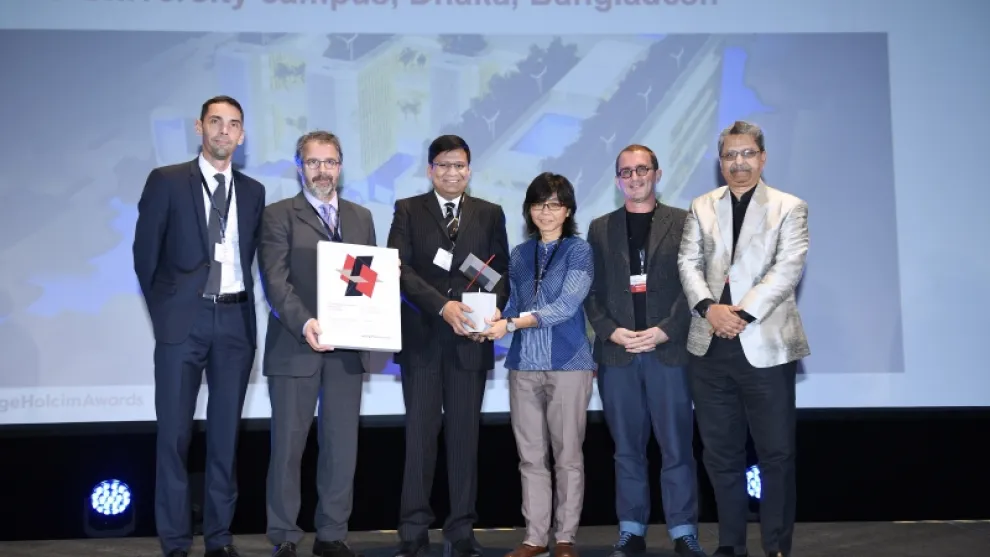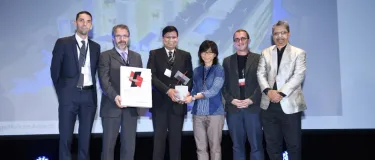LAFARGEHOLCIM AWARD 2017 Floating university building in Bangladeshwon the Bronze Award
Sustainable construction in Asia Pacific also means building for the community. This was clearly shown by the projects that won prizes in the regional LafargeHolcim Awards presented in Kuala Lumpur, Malaysia. The three main Awards winning projects (Gold Award, Silver Award and Bronze Award) deal with buildings for education – involving the community and sustainably improving neighborhoods.
Winner of Bronze Award: Floating University- BRAC University campus, Dhaka, Bangladesh
WOHA from Singapore aims to introduces buildings and open space on remediated swamp land in Dhaka, Bangladesh. This project is led by JalalAhmad, principal architect, J.A. Architects, Dhaka, Bangladesh, Richard Hassell and Sim Choon Heok, architects, WOHA, Singapore, and Wolfgang Kessling, climate engineer, Transsolar Energietechnik GmbH, München, Germany. They designed a university building that floats on a pond – and the overall design supports the cleaning of the pond. With vertical garden facades, photovoltaic panels, and controlled ventilation, this project could become a benchmark for sustainability in the Asia Pacific region. “Sustainability is deeply integrated into the building design, from thermal zoning to significant reductions in the use of energy and water,” stated the jury. This project is promoting human well-being and comfort in the built environment, Enhancing urban biodiversity and Reducing waste, saving energy and water
Mr. Rajesh Surana, Country Representative and CEO LH Bangladesh was present at the event who handed over the award to the winning team.
5th cycle of LafargeHolcim Awards competition
The 5th International LafargeHolcim Awards competition for projects and visions in sustainable construction attracted a total of 5,085 entries by authors in 121 countries. 1,836 projects passed the formal and quality checks and were assessed by five independent regional juries, hosted by partner universities of the Foundation. The winners announced in the fourth quarter of 2017 include three Awards and four Acknowledgements, as well as four Next Generation prizes in each region.
September 7, 2017: Middle East Africa
September 28, 2017: Europe
October 5, 2017: Latin America
October 12, 2017 North America
November 23, 2017 Asia Pacific
For the first time, more entries were received in the Next Generation category for students and young professionals (up to the age of 30) than in the Main category. This confirms the personal engagement in sustainability of the next generation of architects, engineers, planners, and construction specialists.
The 6th International LafargeHolcim Awards competition will open for entries in mid-2019.
LafargeHolcim Award - An initiative of LafargeHolcim Foundation
The LafargeHolcim Foundation for Sustainable Construction was created in 2003 to raise awareness of the important role that architecture, engineering, urban planning and construction have in achieving a more sustainable future. The Foundation is an independent legal entity and supported by LafargeHolcim.
With an equally balanced portfolio between developing and mature markets and a focus on cement, aggregates, and ready-mix concrete, LafargeHolcim is the global leader in the building materials and solutions industry. As urbanization increasingly impacts people and the planet,LafargeHolcim provides innovative products and building solutions with a clear commitment to social and environmental sustainability.
The Foundation expresses the commitment of its sponsor, LafargeHolcim, to social and environmental sustainability. The Group’s Sustainability Strategy – The 2030 Plan – sets a vision that the construction sector of tomorrow will be innovative, climate-neutral and circular in its use of resources. So the world builds better.
Evaluating Sustainable Construction
“Target issues”
The LafargeHolcim Foundation for Sustainable Construction is committed to the underlying principles of sustainability, which assert that long-term development of the built environment requires a balanced interplay of responsible economic, ecological, and social agendas.
To achieve this objective, the LafargeHolcim Foundation and its partner universities have identified five “target issues” that aim to clarify principles for sustaining the human habitat for future generations. These “target issues” serve as criteria for projects submitted for the LafargeHolcim Awards and as a road map for other related activities of the Foundation.
Projects must demonstrate:
Innovation and transferability – Progress
Projects must demonstrate innovative approaches to sustainable development, pushing the envelope of practice and exploring new disciplinary frontiers. Breakthroughs and trend-setting discoveries must be transferable to a range of other applications.
Ethical standards and social inclusion – People
Projects must adhere to the highest ethical standards and promote social inclusion at all stages of construction, from planning and building to use and servicing; to ensure an enduring positive impact on communities. Proposals must demonstrate how they enhance the collective realm.
Resource and environmental performance – Planet
Projects must exhibit a sensible use and management of natural resources throughout their entire life cycle. Long-term environmental concerns, especially pertaining to stocks and flows of material and energy, should be an integral part of the design philosophy.
Contextual and aesthetic impact – Place
Projects must be economically feasible and able to secure financing – whether from public, commercial, or concessional sources – while having a positive impact on society and the environment. Avoiding the wasteful consumption of material resources, an economy of means in construction is to be promoted.







